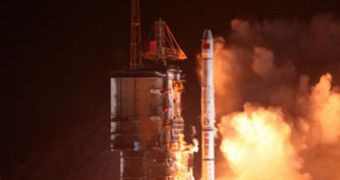Less than a week ago, the Chinese National Space Administration (CNSA) launched a new military communications satellite in Earth's orbit, marking the 14th successful rocket launch in the country for 2010. The agency thus set a new record.
Until now, the Chinese never managed to put more than 11 payloads in space during the same year, but this year has been especially prolific in this sense, as demonstrated by the new spacecraft.
Though official passed as an instrument to help boost the country's radio and TV networks, Western intelligence officials believe the orbital instrument is in fact a military communications device.
The Zhongxing 20A spacecraft is designated Chinasat 20A, and it was inserted following its Wednesday, November 24 launch, into a geosynchronous transfer orbit above the Earth that brought it as close 125 miles at the lowest point.
At the highest altitude, the spacecraft moved some 26,000 miles away from Earth. After this intermediary step was achieved, the satellite began maneuvers to reach a new, more stable orbit.
According to official Chinese statements, the instrument is destined to orbit the planet in a near-circular orbit, at an altitude of about 22,300 miles. On-board propulsion systems provide the thrust needed to make the transfer, CNSA says.
Based on a platform developed by the China Academy of Space Technology (CAST), Chinasat 20A weighed around 5,000 pounds during launch, all maneuvering fuel included.
The DFH-3 satellite platform has been used successfully in the country before, in coordinating secure military communications on the ground, Space reports.
The new spacecraft was delivered to space atop a 172-foot-tall Long March 3A delivery system, which was launched from the Xichang Satellite Launch Center, located in the Sichuan province, southwest China.
More than four decades have passed since the Asian country began its quest to tame space, and the progress that it has made in the field are remarkable.
CNSA has already demonstrated that it can construct lunar orbiters, design manned spacecraft, carry out spacewalks, and plan to prove that the nation is capable of space docking as well.
But, as impressing as its realizations over the past decade or so have been, they pale in comparison to what China wants to do next. It plans to continue operating a Moon mission and build another, and also set the foundations for its own space station.
And the country appears to be on a very strict schedule, because officials in Beijing are not giving themselves enough room to breathe in doing so. All major progress and milestones are being achieved on a yearly basis, which is tremendously fast for the space industry.

 14 DAY TRIAL //
14 DAY TRIAL //